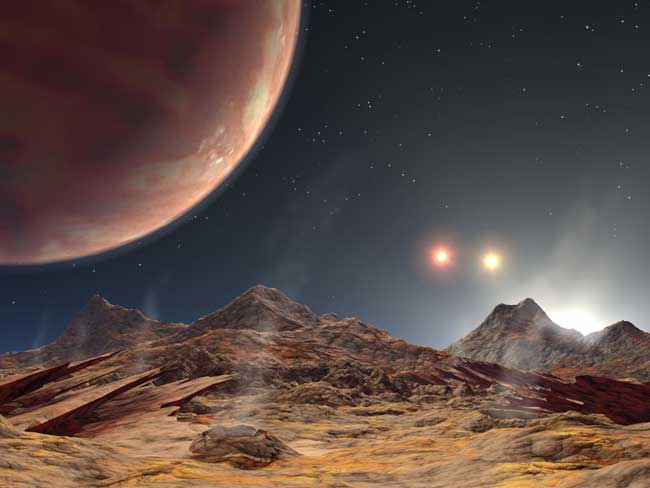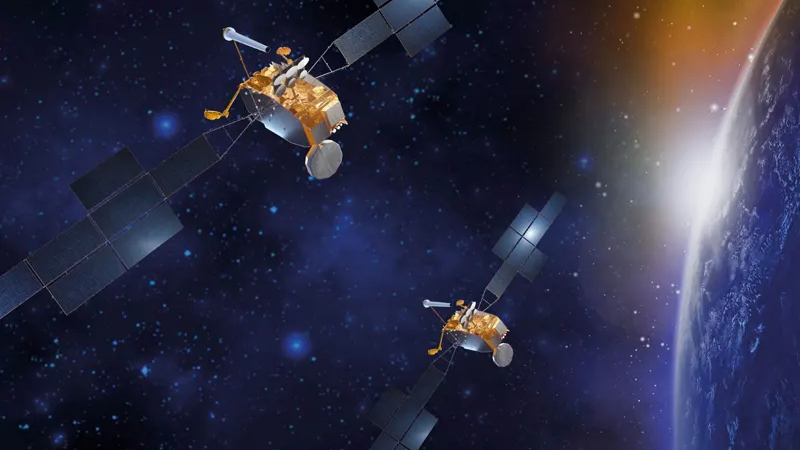Triple Sunset: Planet Discovered in 3-Star System

A newly discovered planethas bountiful sunshine, with not one, not two, but three suns glowing in itssky.
It is the first extrasolarplanet found in a system with three stars. How a planet was born amidstthese competing gravitational forces will be a challenge for planetformation theories.
"The environment in whichthis planet exists is quite spectacular," said Maciej Konacki from theCalifornia Institute of Technology. "With three suns, the sky view must beout of this world -- literally and figuratively."
The triple-star system, HD188753, is located 149 light-years away in the constellationCygnus. The primary star is like our Sun, weighing 1.06 solarmasses. The other two stars form a tightly bound pair, which is separatedfrom the primary by approximately the Sun-Saturn distance.
"The pair more or lessacts as one star," Konacki told SPACE.com.
The combined mass of theclose pair is 1.63 solar masses.
Using the 10-meter Keck Itelescope in Hawaii, Konacki noticed evidence for a planet orbiting the primarystar. This newfound gas giant is slightly larger than Jupiter and whirlsaround its central star in a 3.5-day orbit. A planet so close to its starwould be very hot.
Breaking space news, the latest updates on rocket launches, skywatching events and more!
Although other so-called hotJupiters have been found in such close-in orbits, the nearby stellar pairin HD 188753 likely sheared off much of the planet making material in the diskthat would likely have existed around the primary star in its youth. Since this proto-planetary disk holds the construction materials for planets,there does not appear to be any safe place for this far-off world to have beenassembled.
Snow line andmigration
The heat coming from anearby star frustrates the initial stages of giant planet formation -- thegluing together of planetary seeds, called cores. Therefore, the typicalhot Jupiter is thought to form farther out -- beyond a theoretical limit calledthe snowline.
"Past about 3 AU, it iscold enough to form ices and other solid material for building cores,"Konacki said. An AU is the distance between the Sun and the Earth --about 93 million miles.
Once a sufficiently largecore is built outside the snow line, the planet can start accreting gas and --if the conditions are right -- migratetoward its sun.
Although this scenarioappears to work in most stellar systems, it has difficulty explaining the newly-discoveredplanet in HD 188753. Of all the planet-harboring stars known, this is theclosest that a stellar companion has ever been found.
"The problem is thatthe pair is a massive perturber to the system," Konacki said. "Together, these two stars are more massive than the main star."
Moreover, the pair goesaround the primary along an oblong orbit that stretches from 6 AU out to 18 AUover a 26 year period. This eccentricityincreases the instability of the disk around the primary. Konackiestimates that due to the gravitational perturbations from the pair, theproto-planetary disk was truncated down to 1.3 AU, far within the snow line.
"How that planet formedin such a complicated setting is very puzzling. I believe there is yet much tobe learned about how giant planets are formed," Konacki said.
Targeting multiplestars
Konacki hopes to find moreplanets around stars with companions. About 30extrasolar planets have been found around double-star systems, orbinaries. This is a small percentage of the total number of extrasolarplanets, even though multi-star systems outnumber single star systems.
The reason for thisdisparity is that the main technique for locating planets -- theradial velocity method -- is not well-suited for finding planets with morethan one star.
"Single stars are mucheasier to work with, since the shape of the spectrum stays the same,"Konacki explained.
By watching for wobbles in astar's spectrum, astronomers can infer the gravitational tug from a nearbyplanet. But when there is a companion star, its light competes with thatof the main star. Konacki has developed a method to extract the planetwobbles from this messy, combined spectrum.
He found this triple-sunplanet in the first 20 stars he looked at. He plans to survey about 450stars in the future.
The discovery is reported inthe July 14 issue of Nature. Animations created by JPL'sPlanetQuest show the orbitalmotion of the system, as well as what it looks like from a hypotheticalmoon.

Michael Schirber is a freelance writer based in Lyons, France who began writing for Space.com and Live Science in 2004 . He's covered a wide range of topics for Space.com and Live Science, from the origin of life to the physics of NASCAR driving. He also authored a long series of articles about environmental technology. Michael earned a Ph.D. in astrophysics from Ohio State University while studying quasars and the ultraviolet background. Over the years, Michael has also written for Science, Physics World, and New Scientist, most recently as a corresponding editor for Physics.
